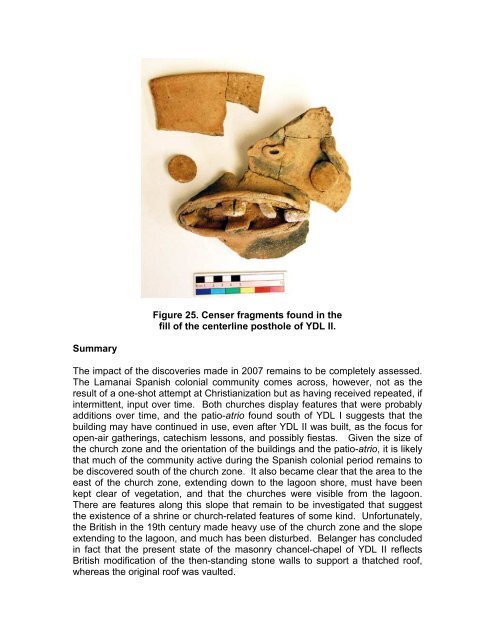Report submitted to FAMSI:
Report submitted to FAMSI:
Report submitted to FAMSI:
You also want an ePaper? Increase the reach of your titles
YUMPU automatically turns print PDFs into web optimized ePapers that Google loves.
Summary<br />
Figure 25. Censer fragments found in the<br />
fill of the centerline posthole of YDL II.<br />
The impact of the discoveries made in 2007 remains <strong>to</strong> be completely assessed.<br />
The Lamanai Spanish colonial community comes across, however, not as the<br />
result of a one-shot attempt at Christianization but as having received repeated, if<br />
intermittent, input over time. Both churches display features that were probably<br />
additions over time, and the patio-atrio found south of YDL I suggests that the<br />
building may have continued in use, even after YDL II was built, as the focus for<br />
open-air gatherings, catechism lessons, and possibly fiestas. Given the size of<br />
the church zone and the orientation of the buildings and the patio-atrio, it is likely<br />
that much of the community active during the Spanish colonial period remains <strong>to</strong><br />
be discovered south of the church zone. It also became clear that the area <strong>to</strong> the<br />
east of the church zone, extending down <strong>to</strong> the lagoon shore, must have been<br />
kept clear of vegetation, and that the churches were visible from the lagoon.<br />
There are features along this slope that remain <strong>to</strong> be investigated that suggest<br />
the existence of a shrine or church-related features of some kind. Unfortunately,<br />
the British in the 19th century made heavy use of the church zone and the slope<br />
extending <strong>to</strong> the lagoon, and much has been disturbed. Belanger has concluded<br />
in fact that the present state of the masonry chancel-chapel of YDL II reflects<br />
British modification of the then-standing s<strong>to</strong>ne walls <strong>to</strong> support a thatched roof,<br />
whereas the original roof was vaulted.
















